Making Your Own Hay
I wonder how many thousands of bunny owners wake up on a Saturday morning, mow their lawn, throw away or compost the clippings, and then pop into the pet shop and tut over the price of hay, that in some cases has been shipped half way around the world. Now the obvious thing would be just to cut a section of grass (with scissors not a mower) and feed that direct to your bunnies, but that isn’t always practical. Some people don’t like to feed fresh grass to buns with sensitive tums, and it’s handy to have a good pile of hay in the litter tray even if you’re topping up with grass at dinner time too. So the next option is to take the lovely fresh grass and dry it so it turns into hay! So, that’s what I did….
Making Hay Step 1: Find Grass
The first step is to find some grass. If you lovingly mow your lawn weekly, you might want to skip a week to let it grow out a bit. We may have taken that to the extreme as our lawn looked something like this:
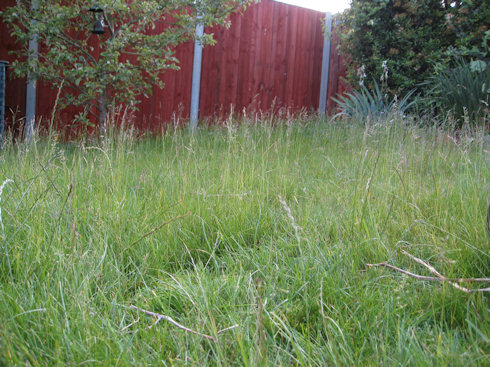
Which was the inspiration for making hay in the first place. If you don’t have a lawn, you could try asking your neighbours – offer to ‘cut’ their grass in exchange for keeping the clippings. Just make sure they don’t use any weedkiller/pesticides.
Making Hay Step 2: Cut the Grass
Once you have located your patch of grass, next you need to cut it. It’s important not to use a lawn mower for this. Mowers chop up the grass and crush it which encourages it to begin fermenting. This is great if you want to compost it but no good for feeding to rabbits. If you’re cutting a big patch you could use scythe (don’t chop off any body parts) but I went for scissors; big hedge scissors would be quicker than kitchen ones if you’re cutting a lot. I filling up this A4 paper box in about a minute… it doesn’t take long.
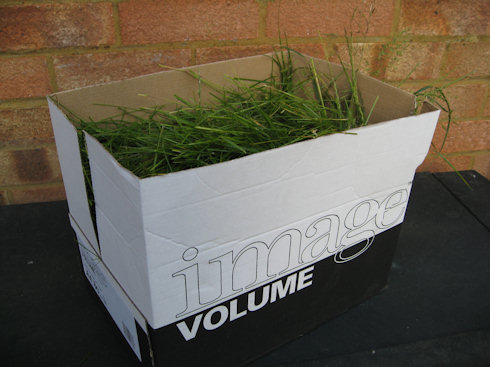
Making Hay Step 3: Drying the Grass
Next is the difficult part, the grass needs to dry out (and turn into hay). There are a few options for this. You could leave the grass where you cut it and turn it a few times to help it dry. The trouble with that is you are at the mercy of the weather. If your grass keeps getting soaked it will turn into a soggy mess instead of hay. It also means your lawn is covered in grass cuttings.
It was raining almost every day when I started so I decided to pop it in my mini greenhouse now the seedlings are mostly outside. It’s important the air gets to it so I made a shelf out of some plastic mesh and left the doors open (a closed greenhouse would get too humid). Note: The foil isn’t part of hay making, it just helps my seedlings grow straight as the greenhouse sits against a wall.
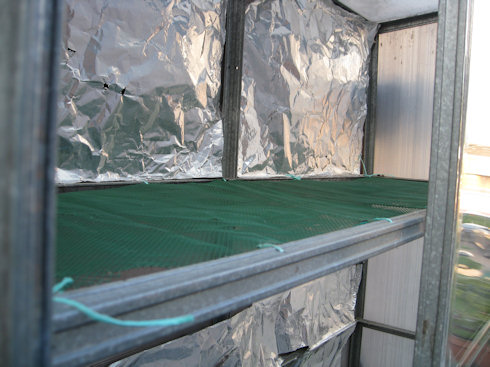
You could also use a covered deck, greenhouse, shed with windows etc. or you could lay it out on a sheet and just pick it up in the sheet when rain is forecast and pop it out afterwards. The top of a wire rabbit run would be great if the weather is a bit drier.
Here is my grass all laid out ready to dry.
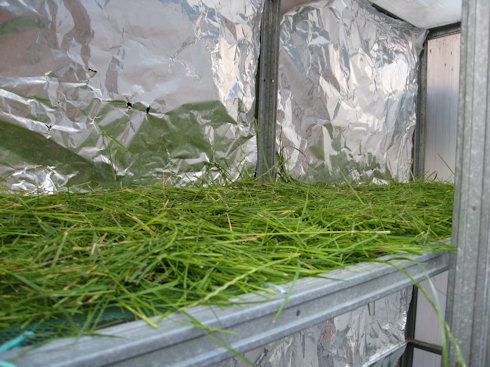
Making Hay Step 4: Wait
That’s it for the hard work, now you just need to wait for it to dry. It didn’t take long like this. In two weeks it smelt and looked like tasty hay.
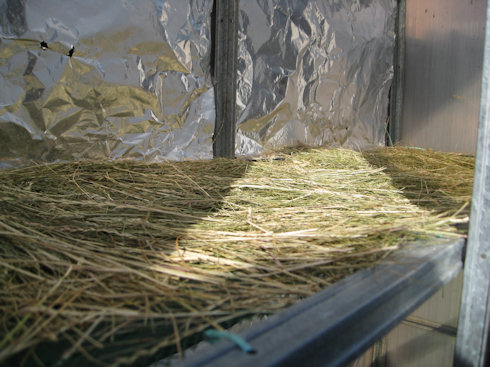
Once it has dried out you can store it like you would normal hay. Something that breaths (like a Hessian bag or pillow case would be best) just in case there is any moisture left. If you leave it out in the sun it will loose the hint of green and go golden brown (still edible but less nutrients).
Making Hay Step 4: Taste Test
The whole point of making hay is producing something tasty for a bunny to eat, so the process wouldn’t be complete without a taste test.
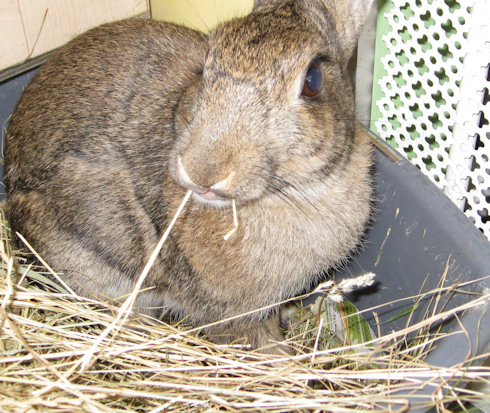
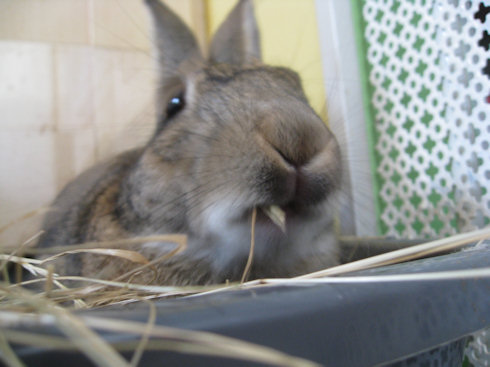
I think it passed!
Conclusion
Okay, so I’m probably not going to make enough hay from our little patch of lawn to supply hay all your around, but it’s a fun experiment and certainly worth the effort if you want to cut down on your expenses, be more environmentally friendly, or just provide an extra treat.


adorable tester! and well worth the effort!
I always go to a local farmer and buy some high quality 2nd cutting hay. At $3-$5 for an entire bale it is so cheap compared (and better quality) to pet store hay!
It looks yummy and it passes the taste test! Hay, my computer died and I had to get a new one, but the new one doesn’t have your email in the address book, not surprising really. Could you email me so I have it? I have a couple of questions before I start on the book. (which is gorgeous).
wow!so easy
[…] http://www.therabbithouse.com/blog/2011/07/01/making-hay […]
hi, i was just wondering what kind of grass you used. i live in suriname, so grass may differ.
I used normal lawn grass, but what we use in lawns might differ in the UK to where you are. Any grass will turn into hay if you dry it out so if your grass is safe for bunnies then give it ago. If you aren’t sure about grass types, try finding out what horses in your local area eat – that’s usually a good guide for bunnies.
Dandelion, alfalfa, willow leaves, etc can make better hay… matter if finding somewheres where weeds are growing so big it is like harvesting from a garden, then usual of spread out thin to dry out.
Old potatoes, apples, etc are also possible food sources, if you have freezer space you can freeze apples that neighbours throw out (from their local apple trees)
Silage may also work, haven’t tried yet, matter of getting moisture content right and excluding air.
Adding other plants in is a great addition to hay, there are a lot of ‘weeds’ that are safe for rabbits to eat and widen the variety of vitamins/minerals they get.
Potatoes is quite an outdated idea for rabbit food – my mum used to give it to her rabbits in the 60’s. Now we know that rabbit needs a much lower carbohydrate/higher fibre diet so they are best avoided. A little apple is okay, but the leaves/branches from pruning the trees would be a better source of food and can be dried like the hay.
May I ask, what Rabbit breed do you have?
He/she looks very similar to mine, and I haven’t been really able to figure out what breed one of my Rabbits are.
By the way I rescue Rabbit, so usually I have to figure out the breed. Now, I know most every breed, but I just
Can’t figure out what breed a certain Rabbit of mine is.
It would be most appreciated if you could tell me your Rabbit breed.
Thank you,
Jessica Keller
Scamp is a European wild rabbit I handreared. If you’re in the UK it’s possible that you might have a wild cross domestic or a rabbit with some wild rabbit in the family history. UK wild rabbits and domestics can cross and I’ve known a few cases where an escaped rabbit has been dallying with wilds and the resulting litter tend to look similar to wild rabbits. They often have more high strung behaviour to go with it too.
You can get wild looking domestics as well though – Belgium hares or rex crosses can give the long narrow shape and agouti (flecks of brown/black) is a domestic colour too so that can be added in by whatever they mixed with.
I might be able to guess if you’ve got a picture?
Sorry, I don’t think those links work, here are new ones.
These are some pictures of him, I also have a picture of his Mom.
I was thinking that he might be a European and Lionhead mix?
These are the pictures of my rabbit Lorance.
(1.) https://www.flickr.com/photos/90513838@N02/16763992863/
(2.) https://www.flickr.com/photos/90513838@N02/17382301432/in/photostream/
(3.) https://www.flickr.com/photos/90513838@N02/17198052969/in/photostream/
(4.) https://www.flickr.com/photos/90513838@N02/17196709430/
This is his mother, a Lionhead.
So, I do know that he is part Lionhead.
(1.) https://www.flickr.com/photos/90513838@N02/16514644485/in/set-72157650775759862
I also have another rabbit (Bell) who I really believe is a European (wild maybe) rabbit. She moves like a wild rabbit (which is hard to explain), she makes kinda jerky like movements, and is alerted to everything, she also is really fast. These are some pictures of her.
(1.) https://www.flickr.com/photos/90513838@N02/16706302673/
(2.) https://www.flickr.com/photos/90513838@N02/17187199638/in/photostream/
(3.) https://www.flickr.com/photos/90513838@N02/17325901151/
I hope that this all helps, and I hope these finally work.. Thank you for the help, I really appreciate it!
Jessica Keller
Lovely bunnies, thank you for sharing the photos.
Lorance (love the name!) is a fairly typical shape for a lionhead so unless you’ve got any history that suggest wild ancestors I’d pop him down as a domestic. Lionheads can vary a lot in how fluffy they are and how big they get. He’s quite chunky looking so he might have some lop crossed in there but he could just as easily have a lionhead dad too.
I don’t think Bell is a full wild rabbit as her face is a little too short and round, but it’s possible she could be a cross. Domestic wise I’d guess Netherland Dwarf and/or some Polish (Britania Petit) – polish rabbits are very similar in shape to wild rabbits and tend to be known for flightly personalities.
I hope that helps 🙂
Thank you, I’m glad you liked my pictures, and I love the name Lorance too!
At first I had wondered whether Lorance had Lop in him, however, I do not know his Dad. All I know is his Mother, because I rescued her from an abusive breeder, and she was pregnant at that time.
Okay, I wondered about Bell’s shorter rounder face, considering wild rabbits (from what I have studied) have a longer thinner face (like your rabbit).
Thank you very much, that was of much help to me.
I really appreciate the time you took,
Jessica Keller
Brilliant! I’ve been thinking about doing this for a while but had no clue how to go about it! I have a rabbit, two jumbo pekin, ducks, two battery hens and a pigeon who will benefit greatly from this and your other cost saving ideas!!!
I was surprised how easy it was and how quick the grass dried, and there are lots of other plants they dry well too. It’s great because not only is it super cheap but I think gives them a better diet too! Good luck with the hay making!
Hello there, I am in N. Ireland and found this site whilst trying to find out how to make hay for my horse. Found this funny as sombody commented on asking what the horses eat. I am checking what the bunnies eat lol. Love the site, very cute photos xo
Wow!
Thank you for this info. I am a farmer from Nigeria. I’ve really learnt. I’m sure that my animals will be happy to have tasty gays henceforth.
We have a handmower and I want to use the hay for an insect hotel. Would this work ok? Wasn’t sure if the hand mower would make it ferment and if it does, if that speeds up decay.
You’d have to try it and see – after cutting spread it out thinly and turn it over regularly – that will help it dry out rather than rot.
Hi, i was just wondering how long you can leave the hay for before using it as we have a large area to grow grass so was hoping to stock it up.
Traditionally hay is used to feed animals through winter whilst there is little fresh grass available. You should be fine using it all winter as long as it’s stored somewhere it won’t get damp and you make sure it’s dry before storing. Stored dry it won’t go bad (hay stored wet will get a mouldy damp smell) but it will lose nutritional content with time i.e. it will be safe to eat but not provide as much nutritional value. I would say say 6 months would be fine. I’d recommend feeding fresh grass whilst you have it and then making/storing hay to see you through winter. If you have a very large area you may still be able to collect some fresh grass through winter too.
wrong wrong wrong. bale hay is straw! small pets like grass hay. they do not like the straw and it’s not as good for them
I’m not sure what comment you are replying to, but hay is cut from green actively growing plants and straw is cut once plants have died. Straw is generally from the stalks left from cereal crops for example wheat. It’s left in the field where it grows until the plant has died and turned brown (straw coloured), which is when the cereal has dried and is ready to harvest. When the cereal is harvested the stalks are then used as straw (which is often baled).
Hay is generally grass, but can also be made from oats or wheat, the difference is that hay is cut when the plant is green and actively growing. Hay can also be baled for transport/storage.
the op’s comment in her blog
bale hay is everything. i live on a farm. a farmer’s daughter and the op said it’s better to buy a bale of hay which it is not. guinea pigs and rabbits like the green leaf stuff. a bale of hay is the straw and green leafy stuff. most guinea pigs and rabbits will only pick through the bale of hay so it’s not a bargain
sorry i meant the stalk not straw
Do you have to wash the grass before letting it dry or you can leave it as it is?
Hi Mimi, No you don’t need to wash it, the hay you buy won’t have been washed prior to drying. Just make sure you pick the grass from a clean area that’s not been soiled by animals or treated with chemicals etc.
Hi
I just read your article on how to make hay with grass great idea I have a rally fussy bunny he won’t eat hay can you dry out Gas’s in a box and how long for thank you for a interesting read
You need the air to circulate around it so I would spread it out somewhere – you can do this inside just on any spare surface you have. Once it’s dry you could then store it in a cardboard box (avoid plastic). How long depends on the temperature/humidity. Usually around a week though.